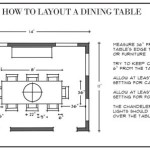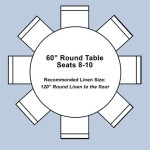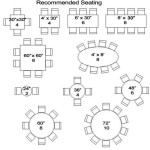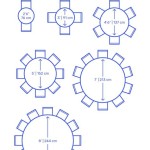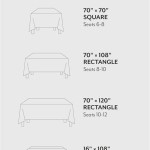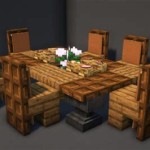How to Measure for an Oblong Tablecloth
Selecting the correct tablecloth is crucial for both aesthetics and functionality. An ill-fitting tablecloth can detract from the overall appearance of a dining table, while an appropriately sized one enhances its visual appeal and protects the table surface. This article provides a comprehensive guide on how to accurately measure for an oblong tablecloth, ensuring a perfect fit for any occasion.
The importance of accurate measurement cannot be overstated. Factors such as the table’s dimensions, the desired drop length, and the occasion for which the tablecloth is intended all contribute to determining the ideal tablecloth size. Rushing the measuring process or relying on estimates can lead to dissatisfaction and the need for exchanges or returns.
Understanding Key Concepts: Table Dimensions and Desired Drop
Before initiating the measuring process, it's essential to grasp two fundamental concepts: table dimensions and desired drop. Table dimensions refer to the length and width of the table itself. These measurements form the basis for calculating the required tablecloth size. The desired drop, on the other hand, represents the amount of fabric that will hang over the edge of the table. This drop is a matter of personal preference and is influenced by the formality of the setting and the overall aesthetic.
The length and width of the table must be determined with precision. Using a flexible measuring tape is highly recommended, as it allows for accurate readings even on tables with curved edges. It is important to measure the longest and widest points of the table to ensure adequate coverage.
The desired drop is a crucial element influencing the aesthetic appeal of the tablecloth. A shorter drop, typically ranging from 6 to 10 inches, is often preferred for casual settings and everyday use. This length provides sufficient protection for the table without being overly formal. Conversely, a longer drop, typically ranging from 10 to 15 inches, is more appropriate for formal occasions such as banquets, weddings, or high-end dining events. A full drop, where the tablecloth nearly touches the floor, is reserved for the most formal settings, although this style can be impractical for everyday use.
When selecting the desired drop, consider the height of the chairs surrounding the table. A drop that is too long may interfere with guests' legs, while a drop that is too short may appear inadequate. A balanced approach that considers both aesthetics and functionality is always advisable. Furthermore, consider the material of the tablecloth. Heavier fabrics may drape differently than lighter fabrics, influencing the perceived drop length.
Step-by-Step Guide to Measuring Your Table
The actual measurement process is straightforward but requires careful attention to detail. Following these steps ensures an accurate determination of the required tablecloth size.
Step 1: Gather Necessary Tools. A flexible measuring tape is the most important tool. A straight edge, such as a ruler or yardstick, can also be helpful for ensuring accurate measurements. A notepad and pen are essential for recording the measurements as they are taken.
Step 2: Measure the Length of the Table. Extend the measuring tape along the longest side of the table, from one end to the other. Ensure the tape is lying flat and straight to avoid inaccurate readings. Record this measurement in inches or centimeters, depending on the preferred unit of measurement.
Step 3: Measure the Width of the Table. Similarly, extend the measuring tape along the shortest side of the table, from one edge to the other. Again, ensure the tape is lying flat and straight. Record this measurement in the same unit of measurement as the length.
Step 4: Determine the Desired Drop. Decide on the desired drop length, considering the formality of the setting and personal preferences. Common drop lengths range from 6 to 15 inches. This measurement will be used to calculate the final tablecloth size.
Step 5: Calculate the Tablecloth Length. Add the desired drop length to each end of the table's length. This means adding the drop length twice to the table's length. For example, if the table is 72 inches long and the desired drop is 10 inches, the calculation would be: 72 inches + 10 inches + 10 inches = 92 inches. This is the required length of the tablecloth.
Step 6: Calculate the Tablecloth Width. Add the desired drop length to each side of the table's width. This means adding the drop length twice to the table's width. For example, if the table is 48 inches wide and the desired drop is 10 inches, the calculation would be: 48 inches + 10 inches + 10 inches = 68 inches. This is the required width of the tablecloth.
Step 7: Finalize the Measurements. The calculated length and width represent the minimum dimensions required for the tablecloth. It is always advisable to round up to the nearest inch to ensure adequate coverage and prevent the tablecloth from being too small. Therefore, in the previous examples, the ideal tablecloth size would be 92 inches long and 68 inches wide.
It is crucial to double-check all measurements and calculations to minimize the risk of errors. A small mistake in the initial measurements can lead to a significant discrepancy in the final tablecloth size.
Accounting for Special Circumstances and Additional Considerations
While the above steps provide a general guideline, certain special circumstances may require adjustments to the measurement process. These include tables with leaves, unusually shaped tables, and the presence of overlays.
Tables with Leaves: Many oblong tables are equipped with leaves that can be inserted to extend the table's length. When measuring for a tablecloth, it is essential to consider both the table's dimensions with and without the leaves. If the tablecloth is intended for use when the leaves are inserted, the measurements should be taken with the leaves in place. Conversely, if the tablecloth is intended for use only when the leaves are removed, the measurements should be taken without the leaves. Ideally, consider purchasing two tablecloths: one for use with the leaves and one for use without.
Unusually Shaped Tables: While this article focuses on oblong tables, some tables may have unusual shapes, such as rounded corners or non-uniform sides. In such cases, it is essential to take measurements at the widest and longest points to ensure adequate coverage. Consider creating a template of the table's shape using paper or fabric to aid in visualizing the required tablecloth size. Consult with a tablecloth vendor for advice on custom sizing options for irregularly shaped tables.
Overlays: An overlay is a smaller tablecloth that is placed on top of a larger tablecloth, adding visual interest and dimension. When measuring for an overlay, the same principles apply as for a regular tablecloth. However, the desired drop for an overlay is typically shorter, ranging from 6 to 8 inches. The overlay should complement the larger tablecloth in terms of color, pattern, and texture. The dimensions of the overlay should be carefully considered to ensure it is proportionate to the size of the table and the underlying tablecloth.
Seam Considerations: For very large tables, it may be necessary to use a tablecloth that is constructed from multiple pieces of fabric sewn together. These seams can affect the drape and appearance of the tablecloth. When selecting a large tablecloth, inquire about the placement and visibility of the seams. Opt for tablecloths with well-hidden seams that do not detract from the overall aesthetic.
Material Shrinkage: Different fabrics have different shrinkage rates. Natural fibers such as cotton and linen are more prone to shrinkage than synthetic fibers such as polyester. When selecting a tablecloth made from natural fibers, it is advisable to allow for a small amount of shrinkage, typically 1-3 percent. This can be done by adding a few extra inches to the calculated tablecloth size. Always follow the manufacturer's care instructions to minimize shrinkage during washing and drying.
By understanding these key concepts, following the step-by-step measuring guide, and accounting for special circumstances, anyone can confidently measure for an oblong tablecloth and select the perfect size for their table.

Tablecloth Size Calculator Williams Sonoma Taste

Tablecloth Size Calculator Find The Right

Oval Sunflower Tablecloth Yellow Fabric 54 X 72 Wrinkle Resistant And Washable Fl Table Cloths Perfect For Kitchen Dinner Family Gathering Holiday Dining Room Com

Tablecloth Size Calculator Find The Right

Tablecloth Size And How To Choose The Right One

What Size Tablecloth Do I Need Deconovo Us

How To Choose The Best Tablecloth For Your Table

Sophia Tablecloth By Oakridgetm 60 X 90 Oblong Com

Use This Tablecloth Size Chart For Perfect Party Planning Lovetoknow

How To Choose The Correct Size Tablecloth For Your Table
Related Posts


